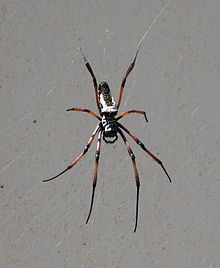- Nephila inaurata
-
Nephila inaurata 
Scientific classification Kingdom: Animalia Phylum: Arthropoda Class: Arachnida Order: Araneae Suborder: Araneomorphae Family: Nephilidae Genus: Nephila Species: N. inaurata Binomial name Nephila inaurata
(Walckenaer, 1842)Synonyms Epeira inaurata
Epeira geniculata
Epeira nigra
Nephila ardentipes
Araneus geniculatusThe red-legged golden orb-web spider (Nephila inaurata) is a species of golden orb-web spider. It lives in Southern Africa and several islands in the Indian Ocean (Madagascar, the Seychelles, Réunion, Mauritius, Rodrigues). Like other spiders in the family Nephilidae it can weave webs so strong that sometimes even birds and bats get caught.[verification needed] Its webs can be found in damp places such as large trees and unpolluted areas to which no cars have access; normally several are strung together to form enormous "homes" so as to cover as much surface area as possible.[verification needed]
This species feeds on flies, mosquitoes, moths, wasps and unfortunate beetles who happen to get tangled up.
In addition to the nominate (Nephila i. inaurata), a second subspecies is currently recognized: Nephila inaurata madagascariensis (Vinson, 1863), which occurs from South Africa to the Seychelles.
This species is commonly kept in captivity. Egg sacks the size of a small marble are made of thick silk and contain 100-200 eggs which hatch after two months. They start out with a 2mm legspan and grow rapidly. Males mature in one to two months depending on the form. A small percentage of males mature early and resemble a small, black crab spider with only an 8-10mm legspan. Most males mature later and resemble the form of the female but have very little color and only a 25-30mm legspan. Mature males are rarely, if ever, observed feeding. Females mature in four months with an approximate 100mm legspan. [Source "Golden Silk Spiders", Invertebrate-Magazine Vol.4, Issue 2 March 2005]
An example of a tapestry woven entirely from the madagascariensis subspecies' silk can be seen at this link: [1]

This spider–related article is a stub. You can help Wikipedia by expanding it.


